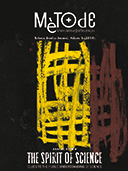Ciencia, público y nuevos medios. Reflexión sobre el presente y el futuro de la divulgación científica
DOI:
https://doi.org/10.7203/metode.80.3123Palabras clave:
ciencia y redes sociales, comunicación on-line, divulgación científica, percepción pública de la ciencia Resumen
Resumen
El periodismo científico se enfrenta al reto de adaptarse no solo a nuevos formatos sino también a las nuevas formas de intercambio de información. Las nuevas plataformas digitales facilitan el acceso y la producción de contenido científico y, por lo tanto, fuerzan a su audiencia a evolucionar. La red se ha convertido en el presente de la divulgación científica, y tanto los científicos como los comunicadores deben adaptarse a ella. En este artículo analizaremos estos cambios y las implicaciones que tienen para el periodismo científico y para conseguir una ciudadanía informada.
 Descargas
Descargas
 Citas
Citas
Anderson, A. A.; Brossard, D.; Scheufele, D. A.; Xenos, M. A. and P. Ladwig, 2013. «The “Nasty Effect”: Online Incivility and Risk Perceptions of Emerging Technologies». Journal of Computer Mediated Communication. DOI: <10.1111/jcc4.12009>.
Brossard, D., 2013. «New Media Landscapes and the Science Information Consumer». Proceedings of the National Academy of Science of the United States of America, 110: 14096-14101. DOI: <10.1073/pnas.1212744110>.
Brossard, D. and D. A. Scheufele, 2013. «Science, New Media, and the Public». Science, 339(6115): 40-41. DOI: <101126/science.1232329>.
Brossard, D.; Simis, M.; Yeo, S. and D. A. Scheufele, 2013. Scientists and Social Media at a R1 American University. University of Wisconsin. Madison.
Colson, V., 2011. «Science Blogs as Competing Channels for the Dissemination of Science News». Journalism, 12(7): 889-902. DOI: <10.1177/1464884911412834>.
Corley, E. A.; Kim, Y. and D. A. Scheufele, 2011. «Leading U.S. Nano-scientists’ Perceptions about Media Coverage and the Public Communication of Scientific Research Findings». Journal of Nanoparticle Research, 13(12): 7041-7055. DOI: <10.1007/s11051-011-0617-3>.
Dudo, A.; Dunwoody, S. and D. A. Scheufele, 2011. «The Emergence of Nano News: Tracking Thematic Trends and Changes in Media Coverage of Nanotechnology». Journalism & Mass Communication Quarterly, 88(1): 55-75. DOI: <10.1177/107769901108800104>.
Economisti-Associati, 2011. Feasibility Study for the Preparatory Action «ERASMUS for Journalists»: Part 2 – Statistical Review. Economisti Associati. Bologna.
Fausto, S. et al., 2012. «Research Blogging: Indexing and Registering the Change in Science 2.0». PLoS ONE, 7(12): e50109. DOI: <10.1371/journal.pone.0050109>.
Horrigan, J., 2006. The Internet as a Resource for News and Information about Science. Pew Internet & American Life Project. Washington.
International Telecommunication Union, 2012. Measuring the Information Society. ICT Data and Statistics Division, International Telecommunication Union. Geneva.
LaBarre, S., 2013. «Why We’re Shutting off Our Comments». Popular Science, 24 September.
Ladwing, P.; Anderson, A. A.; Brossard, D.; Scheufele, D. A. and B. Shaw, 2010. «Narrowing the Nano Discourse?». Materials Today, 13: 52-54. DOI: <10.1016/51369-7021(10)70084-5>.
Newman, N. and D. A. L. Levy, 2013. Reuters Institute Digital News Report 2013. Reuters Institute for the Study of Journalism. University of Oxford. Oxford.
Nirenberg, M. W., 1967. «Will Society Be Prepared?». Science, 157(3789): 633. DOI: <10.1126/science.157.3789.633>.
Olmstead, K., Mitchell, A. and T. Rosenstiel, 2011. «Navigating Online News: Where People Go, How They Get There and What Lures Them Away». Pew Research Journalism Project. Available at: <http://www.journalism.org/2011/05/09/navigating-news-online>.
Scheufele, D. A.; Hardy, B. W.; Brossard, D.; Wiasmel-Manor, I. S. and E. Nisbet, 2006. «Democracy Based on Difference: Examining the Links between Structural Heterogeneity, Heterogeneity of Discussion Networks, and Democratic Citizenship». Journal of Communication, 56(4): 728-753. DOI: <10.1111/j.1460-2466.2006.00317.x>.
Shoemaker, P. and T. Vos, 2009. Gatekeeping Theory. Routledge. New York.
Descargas
Publicado
Cómo citar
-
Resumen1224
-
PDF 383
-
PDF (Català)140
-
PDF318
Número
Sección
Licencia
![]()
Todos los documentos incluidos en OJS son de acceso libre y propiedad de sus autores.
Los autores que publican en esta revista están de acuerdo con los siguientes términos:
- Los autores conservan los derechos de autor y garantizan a Metode Science Studies Journal el derecho a la primera publicación del trabajo, licenciado bajo una licencia de Creative Commons Reconocimiento-NoComercial-SinObraDerivada 4.0 Internacional, que permite a otros compartir el trabajo con un reconocimiento de la autoría del trabajo y citando la publicación inicial en esta revista.
- Se permite y se anima a los autores a difundir sus trabajos electrónicamente a través de páginas personales e institucionales (repositorios institucionales, páginas web personales o perfiles a redes profesionales o académicas) una vez publicado el trabajo.





